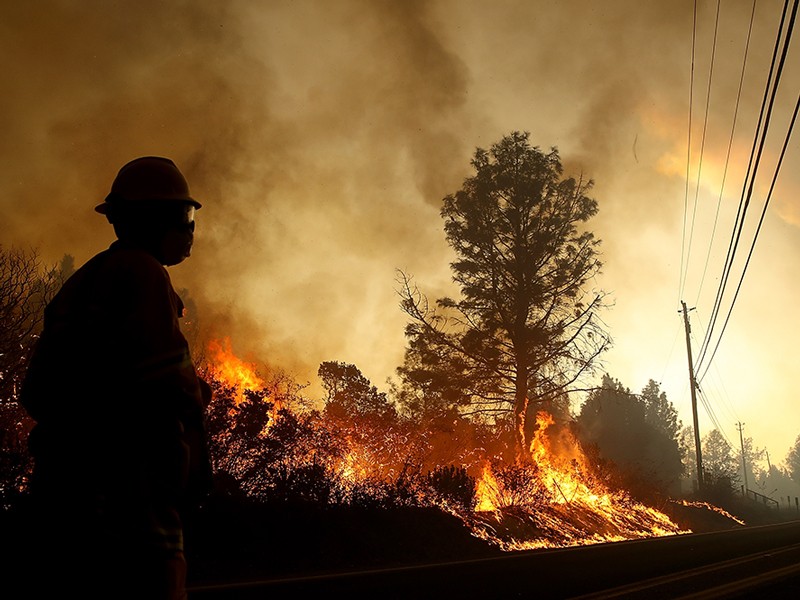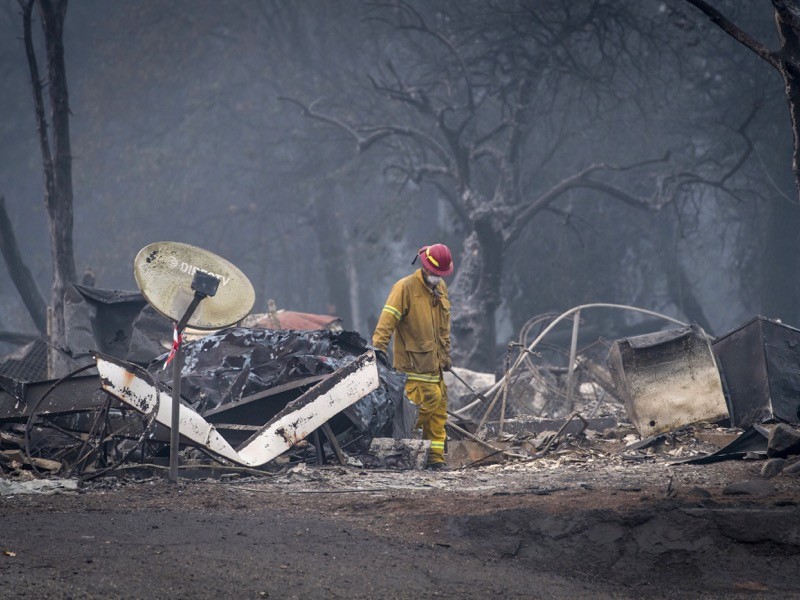From California’s deadliest blaze to a new planetary fire regime, how wildfires are reshaping our climate-changed planet.
Fires are now outside of all norms. Ignitions become infernos; places that have always burnt are burning in new ways. Climate change has supercharged wildfires well beyond humanity’s control. There is plenty to burn, and we are making it worse as we unlock the carbon laid down millions of years ago and release it into the atmosphere.
There is no return from the Pyrocene.

The Camp Fire devastated the town of Paradise, California, in November 2018
Paradise: One Town’s Struggle to Survive an American Wildfire
Lizzie Johnson
Crown (2021)
The Pyrocene: How We Created an Age of Fire, and What Happens Next
Stephen J. Pyne
Univ. California Press (2021
9 September 2021 (Milos, Greece) – On the morning of 8 November 2018, an electrical-transmission tower in the foothills of northern California sent sparks raining into the bone-dry vegetation below. Strong winds fanned the flames and flung showers of embers ahead of the fire’s ferocious advance. Within hours it had obliterated several mountain communities, including the town of Paradise. Eighty-five people died; it was the deadliest California wildfire so far.
The tale encapsulates many aspects of how wildfire is transforming lives around the globe. Ageing electrical-power infrastructure raises the risk of a fire igniting. Climate change brings drought, which transforms trees and grasses into kindling. Economic inequality pushes people out of overpriced cities and into more-affordable rural areas — in the path of wildfires. And poor municipal planning turns evacuation routes into death traps: roads become clogged with vehicles trying to flee a fire storm.
It is these many facets and scales that make grappling with the concept of wildfires challenging, as shown in two unforgettable books, Paradise and The Pyrocene. Wildfire is simultaneously a very local problem — what happens to a particular community when the flames reach it — and a very global one — what happens when climate change and humans fundamentally transform a fire-prone landscape.
Smoking ruin
Journalist Lizzie Johnson illuminates the local problem in her heartbreaking account of the Paradise inferno of 2018. A reporter at the San Francisco Chronicle when the fire broke out, she drove into the smoking remains to cover the story. She spent years following the aftermath, moving to the town part-time to embed herself in the community.
This unparalleled access infuses searing detail into Johnson’s narrative. A mother and her hours-old baby find a lift in a stranger’s car, only to be trapped in the monstrous traffic jam heading out of Paradise. A maintenance man at a nursing home helps to lift its frail residents into the trucks of volunteers, even as his boss mulls whether they should wheel evacuees along the road in the hope of finding rides for more of them as the flames close in. A couple load their cat into a Tupperware container and seal it with duct tape, because they don’t own a pet carrier.

The fire in Paradise was triggered by sparks from electrical lines.
After the fire, revelations unspooled. Community planners who had known that Paradise was at high risk of wildfire had never envisaged that the entire town would have to evacuate at once. Their emergency strategies utterly failed in the face of the scale of the disaster. Meanwhile, finger pointing continued at many levels of government, with the Pacific Gas and Electric company ultimately being held accountable, because it owned the transmission line that ignited the blaze.
The story has been told before, in media and film accounts and in Fire in Paradise, a 2020 book by Alastair Gee and Dani Anguiano, journalists at The Guardian. But Johnson’s deep experience as a fire journalist makes her account the best of the bunch. Among other insights, she interweaves an oral history of fire from the Konkow (also known as Maidu) people, who live in the area. For more than 9,000 years, Indigenous peoples managed the region’s landscape, intentionally setting low-intensity fires to clear brush, a practice that kept the forest healthy and reduced the fuel available to burn. Konkow knowledge includes the story of two wayward boys who threw pitch-pine sticks onto a camp fire, triggering a fire that killed most people in the area. Substitute ‘transmission lines’ for ‘pitch-pine sticks’, and you have the Paradise tragedy.
Ages of fire
Indigenous burning has shaped the planet for tens of thousands of years. In The Pyrocene, fire historian Stephen J. Pyne collects and expands on some of his previously published thoughts about the interaction between humanity and fire. Far from a narrow focus on one California town, he writes across landscape and time and planetary history.
Pyne’s argument is framed around his long-standing concept of ‘first fire’ (primordial burning on early Earth, for instance from lightning or from volcanoes), ‘second fire’ (that lit by humans to cook food and provide warmth) and ‘third fire’ (that stemming from the combustion of fossil fuels). He repurposes his earlier writings on the Pleistocene epoch to draw comparisons between the past ice age and the new fire age. Readers accustomed to Pyne’s oeuvre will find much familiar here.
But The Pyrocene is his fullest elucidation yet of how humanity has entered a new age of fire, one that redefines the human-altered era of the Anthropocene. And Pyne, a former smoke-spotter who tracked blazes at Grand Canyon National Park in Arizona, is certainly the best writer to make this argument. His previous books documented cultural and political practices that led to Earth’s current fire regime. One such is the ‘10 a.m.’ policy (now mostly abandoned) of the US Forest Service, which held that fires ignited on federal land should be extinguished by that time the following morning. What sounded like a well-planned effort to prevent forest fires instead led to decades of fire suppression and the dangerous build-up of brush in landscapes that would have functioned much better with occasional low-intensity burns. Similar policies in Australia shifted the continent from a well-managed fire regime to a highly combustible one.
Fires are now outside of all norms. As the story of Paradise shows, ignitions become infernos; places that have always burnt are burning in new ways. Climate change has supercharged wildfires well beyond humanity’s control. Extreme fire behaviour includes spirals of flame, dubbed firenadoes, and towering smoke clouds that spawn their own thunderstorms. The Bootleg megafire that burnt this July and August in southern Oregon created its own weather for weeks. Smoke from the devastating Australian bush fires of 2019–20 encircled the globe, having a bigger impact on global climate than the COVID-19 lockdowns. This is the new age of megafires.
Earth is the only planet with fire; the very fact that it burns at all is a quirk of atmospheric chemistry. But there is plenty to burn, and we are making it worse as we unlock the carbon laid down millions of years ago and release it into the atmosphere. There is no return from the Pyrocene.